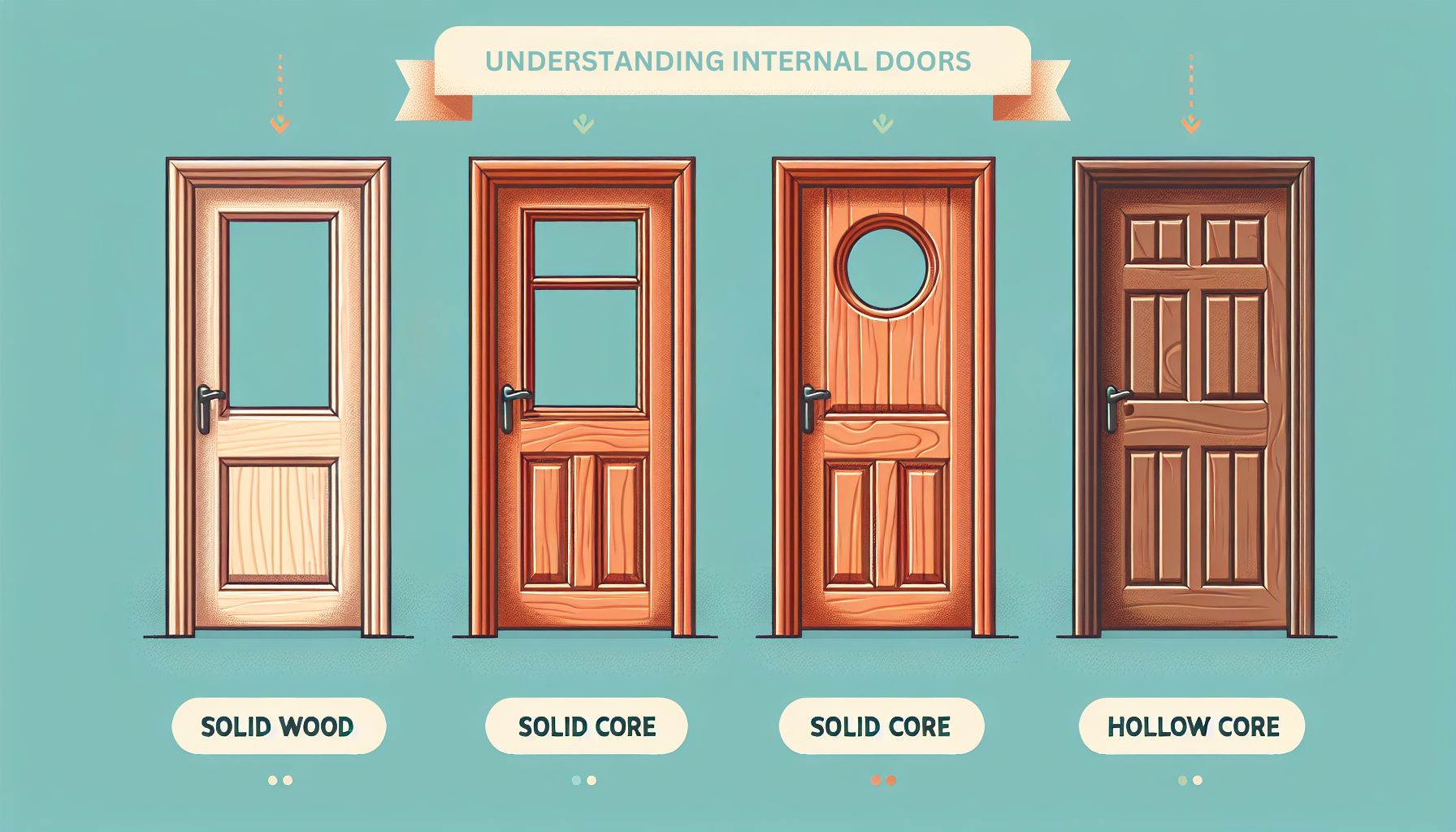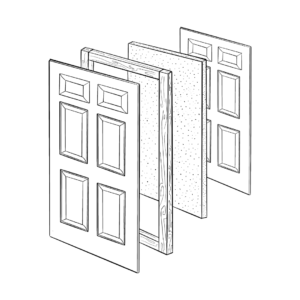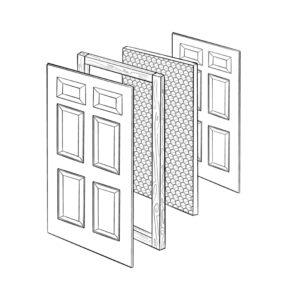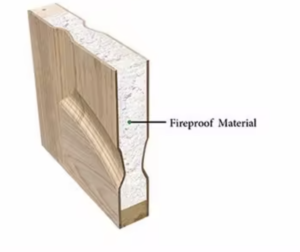As a specialist with a deep understanding and experience in interior doors, I’ve seen how internal doors serve not just as a barrier for privacy and space separation but also play a crucial role in the aesthetic unity of a home’s decor. They are distinct from external doors, designed with either solid or lightweight cores to suit their indoor roles, equipped with different types of hardware since they do not require the same level of security[1]. Additionally, the choice between styles like oak doors, shaker doors, internal sliding doors, and interior French doors, among others, can significantly affect both the functionality and the visual appeal of a space[2]. Not to mention, selecting the right type of door, be it fire doors, flush doors, or internal bi-fold doors, can greatly enhance the home’s acoustic insulation and temperature control.
Understanding the intricate details between solid wood, solid core, and hollow core doors is essential for any homeowner looking to make an informed decision. My article will navigate through these types, shedding light on their performance, applications, and how they contribute to a home’s overall decor and functionality. Whether you’re considering panel doors that add a touch of elegance, or internal doors with glass that brighten a room, selecting the right internal door is a step toward achieving both practicality and aesthetic harmony in your home.
Solid Wood Doors
![]()
Solid wood doors, embodying tradition and quality, stand as a testament to classic craftsmanship in the realm of internal doors. As an SEO specialist with expertise in internal doors, I’ve observed these key elements that distinguish solid wood doors:
- Construction and Material Quality:
- Made entirely of 100% natural wood, not engineered, ensuring each door is unique with its wood grain and texture [4].
- Available in a variety of wood types such as oak, pine, mahogany, and more, catering to diverse aesthetic preferences and architectural styles [5].
- Solid wood doors are constructed using frames and panels, which can vary from hardwood to softwoods, providing versatility in design and application.
- Performance and Durability:
- Renowned for their excellent insulation, sound-proofing capabilities, and overall durability, making them ideal for maintaining privacy and comfort in any space.
- They offer good thermal insulation, keeping rooms warm in winter and cool in summer, and are effective in reducing noise, making them suitable for homes with children or in noise-sensitive environments [6][9].
- Solid wood doors are highly durable and resilient, capable of withstanding significant wear and tear. They are easy to repair if dented or scratched, ensuring a long lifespan [7].
- Aesthetic Appeal and Environmental Impact:
- Available in various design styles, including flush, panel (e.g., 3-panel, 5-panel), and glazed doors, allowing for customisation to enhance the interior decor of any building [5].
- Choosing a solid wood door is an environmentally friendly option due to their longevity and the natural insulation they offer, reducing the need for artificial heating and cooling.
- Despite being more expensive than other types of doors, solid wood doors are considered a good investment due to their ability to enhance property value through their visual appeal and functional benefits.
In summary, solid wood doors are not just a choice for those looking to add a touch of elegance to their interiors but also for environmentally conscious individuals seeking durable, high-quality options. Regular maintenance, such as waxing or polishing, is essential to preserve their appearance and functionality over time.
Solid Core Doors
Solid core doors, as an integral component in the realm of internal doors, offer a blend of durability, aesthetics, and performance. Drawing from my experience as an SEO specialist with expertise in internal doors, I’ve dissected their features and benefits to aid in understanding their value:
- Construction and Material:
- Engineered from non-natural woods such as MDF, solid core doors are enveloped in a basic wood veneer skin followed by a fine wood or veneer finish .
- The core is typically made from heavy fiberboard, crafted from processed wood chips, ensuring robustness and a substantial feel.
- Exterior finishes often involve higher quality materials like hardwood veneer, elevating the door’s aesthetic appeal [11].
- Performance and Durability:
- Known for their exceptional noise-cancelling qualities, solid core doors significantly reduce sound transmission, making them ideal for privacy and quiet environments [3].
- Their engineered construction provides excellent thermal insulation, reducing heat loss and contributing to energy efficiency.
- Solid core doors exhibit a high level of durability, resisting wear and tear with minimal maintenance required, thanks to their engineered makeup.
- Pros and Cons:
- Pros: Enhanced sound control and privacy; Robust and functional with a high-quality feel; Offers aesthetic versatility; Good level of fire resistance; More affordable than solid wood doors [13][14][17].
- Cons: Heavier, making installation more challenging; Higher initial cost compared to hollow core doors; While they mimic the quality of solid wood doors, they don’t quite match up in terms of texture and finish [10].
Considering their attributes, solid core doors stand out as a prudent choice for those seeking a middle ground between the authenticity of solid wood and the affordability of hollow core doors. Their engineered construction not only delivers on performance but also on long-term value, making them a worthy investment for interior spaces where sound insulation, durability, and aesthetic appeal are prioritised.
Hollow Core Doors
Hollow core doors, often chosen for their affordability and lightweight design, present a practical solution for interior doors where budget and ease of installation are key considerations. My expertise in internal doors has led me to identify several critical aspects of hollow core doors that potential buyers should be aware of:
- Construction and Material:
- Typically made from a thin layer of wood or fiberboard, hollow core doors feature a honeycombed interior core of cardboard or plastic, providing a basic level of privacy and separation between rooms [15].
- The outer surface may be made of fiberboard or laminated wood, with the core designed to reduce material costs and weight, making these doors significantly lighter than their solid counterparts.
- Performance and Affordability:
- Pros:
- Cost-effective, being generally cheaper than solid wood and solid core doors, making them an attractive option for those on a tight budget [17].
- Easy to install due to their lightweight nature, requiring minimal effort and hardware, which can further reduce installation costs.
- With advancements in manufacturing, some hollow core doors are designed to mimic the appearance of more expensive door types, offering a compromise between cost and aesthetic.
- Cons:
- Lower durability and resistance to damage; they are prone to breakage and can easily be compromised with sufficient force.
- Poor insulation and soundproofing qualities, making them less ideal for areas where noise reduction or temperature control is a priority.
- Susceptible to moisture damage, which can lead to delamination (peeling apart) of the door’s layers if exposed to water for prolonged periods.
- Pros:
- Lifespan and Maintenance:
- Hollow core doors have an estimated average lifespan of around 40 years, though this can vary widely from 10 to 50 years depending on the level of care and the environment in which they are used [18].
- They require careful handling to avoid damage. While they can be trimmed for fitting, excessive trimming may compromise the door’s structural integrity.
- Maintenance involves regular checks for signs of wear or damage, especially around the edges and surfaces, to ensure they remain in good condition.
In my role as an SEO specialist with a focus on internal doors, I’ve observed that hollow core doors serve well in specific scenarios, such as in rental properties, low-traffic areas, or where budget constraints are significant. However, it’s crucial for homeowners to weigh these factors against their needs for durability, sound insulation, and overall door performance.
Comparative Analysis: Performance and Applications
Drawing from my expertise as an SEO specialist in internal doors, the comparative analysis of performance and applications of various internal door types is pivotal for homeowners. This section delves into the practical implications of choosing between different internal door materials and styles, focusing on their performance in real-life applications:
- Materials & Styles:
- Wood: Offers a timeless appeal and excellent durability. Solid wood doors are superior in sound insulation and thermal performance, making them ideal for areas requiring privacy and comfort. Styles range from traditional panel doors to modern flush doors, fitting various aesthetic preferences [20].
- Glass: Ideal for spaces requiring natural light. Internal glazed doors add a modern touch and can connect spaces visually. However, they may not be suitable for all areas due to privacy concerns.
- Metal: Provides a contemporary look with various finishes. Metal doors are less common in residential settings but can offer a unique aesthetic and are popular in commercial environments for their style and visibility.
- Composite: Moulded doors, made from compressed wood fibres, offer a cost-effective alternative with a variety of designs. They are a practical choice for homeowners looking for style on a budget.
- Door Opening Styles & Applications:
- Sliding Doors: Best for limited spaces, allowing for efficient use of room areas without the intrusion of door swings. They are also excellent for connecting indoor spaces to outdoor areas, providing both functionality and aesthetic appeal.
- French Doors: Add elegance and are suitable for dividing spaces while maintaining an open feel. They can be made from wood, metal, or glass, offering versatility in design to match home decor.
- Barn Doors: Serve as a unique style statement and are adaptable to various materials. They are particularly suited for larger openings and can add a rustic or industrial touch to interiors.
- Special Considerations:
- Fire Safety: Internal doors in areas requiring fire safety measures should be CE marked and fire protected. Fire doors, especially, need professional fitting with appropriate hardware to ensure safety [19].
- Humidity Resistance: For areas like bathrooms and kitchens, choosing doors made from materials like fiberglass or frosted glass can offer better resistance to humidity and prevent warping or damage.
- Cost Implications: The choice of door material and style significantly impacts the overall cost. Solid wood doors are at the higher end of the price spectrum, offering longevity and aesthetic value, whereas hollow core doors provide a budget-friendly option with lower durability and sound insulation.
- Fire Safety: Internal doors in areas requiring fire safety measures should be CE marked and fire protected. Fire doors, especially, need professional fitting with appropriate hardware to ensure safety [19].
In my role, understanding the nuances of internal doors has shown me that the right choice depends on balancing practical requirements with aesthetic preferences. Homeowners should consider the specific applications of each room, desired maintenance levels, and budget constraints to select the most suitable internal door type.
Choosing the Right Door for Your Home
Choosing the right internal door for your home involves considering several factors to ensure that your choice not only matches the aesthetic of your space but also fulfills functional requirements. Drawing from my experience as an SEO specialist with expertise in internal doors, here are some key considerations:
- Style of Your Home:
- Traditional Homes: Solid wood or panel doors enhance the classic look [22].
- Modern Homes: Flush doors, glazed doors, or internal doors with glass offer a sleek appearance.
- Eclectic Spaces: Mix and match materials like metal or composite for a unique vibe.
- Functionality and Purpose:
- Privacy: Solid wood or solid core doors are preferable for bedrooms and bathrooms due to their soundproofing qualities.
- Decorative: Glazed doors or internal doors with glass can serve as statement pieces in living areas .
- Specialised Needs: Fire doors for safety, moulded doors for budget-friendly options, and doors with specific resistance for bathrooms and kitchens.
- Measurement and Installation:
- Budget Considerations:
- Solid wood doors are generally more expensive but offer durability and aesthetic appeal.
- Hollow core doors are a cost-effective option suitable for low-traffic areas or rental properties.
- Remember to factor in additional costs such as door frames, casings, ironmongery, and security fittings as per the manufacturer’s guidance.
In summary, the selection of an internal door should be a balance between the style of your home, the door’s functionality, the size and installation requirements, and your budget. It’s essential to consider the room’s size, feel, and functionality requirements alongside the material’s durability, insulation, soundproofing, and aesthetics. Always refer to the manufacturer’s guidance and installation instructions to ensure that your choice aligns with your home’s needs and your personal style preferences.
Conclusion
Navigating through the complexities of selecting the perfect internal door for your home, we’ve journeyed together from the sturdiness of solid wood doors, through the balanced attributes of solid core doors, to the practicality of hollow core options. Each type of door, with its unique characteristics, offers distinct advantages and considerations for homeowners. Leveraging my experience as an SEO specialist in internal doors, it’s become clear that the true art of choosing lies in aligning these door attributes with your specific home aesthetics, functionality needs, and budgetary constraints, ensuring that every door complements and enhances the spaces it occupies.
In summary, the decision on which internal door best suits your home is intrinsically linked to a holistic consideration of the door’s performance, aesthetic appeal, and the specific requirements of each space within your home. The insights shared aim to empower you, guiding your selection towards doors that not only fulfill the practical aspects of privacy, insulation, and security but also contribute beautifully to your interior’s overarching theme and decor. As we close this discussion, remember that each door in your home holds the potential to enhance both the functionality and aesthetic appeal of your space, making your selection process an important part of creating a home that truly reflects your style and meets your needs.
FAQs
What distinguishes solid core doors from hollow core doors?
Solid core interior doors consist of a blend of wood and synthetic wood materials, offering a robust and dense construction. In contrast, hollow core interior doors are built with a honeycomb cardboard core, encased in a veneer or fibreboard. Despite their name, they aren’t entirely hollow, but their lightweight nature makes them seem so.
How can I determine whether my door is solid core or made of solid wood?
To ascertain if your door is solid core or solid wood, you can perform a few simple checks. Solid wood doors are typically heavier and have a more natural wood grain pattern on their surface. You can also knock on the door; a solid wood door will produce a dense, solid sound, while a solid core door will have a slight echo due to the combination of materials used within.
Is it advisable to have interior doors made of solid wood?
While not necessary for all rooms, solid core doors are an excellent choice for areas where you desire enhanced quality, including additional privacy and better sound insulation. These doors are particularly suitable for bedrooms, bathrooms, and home offices.
What are the various types of internal doors available?
There are several styles of internal doors to choose from:
- Flush Doors: These are the most straightforward design, with a smooth, flat surface.
- Panel Doors: Commonly encountered, these doors feature raised or recessed panels.
- Cottage Doors: Characterised by their rustic appearance, often with horizontal planks.
- Ledged Doors: Simple in design, with horizontal ledges on the door’s back.
- Ledge and Brace: Similar to ledged doors but with diagonal braces for added strength and character.
References
[1] – https://www.wonkeedonkeexljoinery.co.uk/internal-doors/a-brief-guide-to-internal-doors/
[2] – https://www.wickes.co.uk/buying-guides/internal-doors
[3] – https://www.wooduchoose.com/blog/guide-to-choosing-internal-doors/
[4] – https://www.aspire-doors.co.uk/blog/which-type-of-door-is-best-for-my-home-hollow-core-solid-core-or-solid-wood-door
[5] – https://www.ukoakdoors.co.uk/blog/articles/solid-wood-internal-doors-guide
[6] – https://www.woodgrain.com/benefits-of-wood-doors/
[7] – https://onlinedoorstore.co.uk/blog/why-internal-doors-are-best-made-from-solid-wood/
[8] – https://www.travisperkins.co.uk/trade-corner/internal-doors-buying-guide
[9] – https://www.thespruce.com/hollow-core-vs-solid-wood-doors-1821449
[10] – https://medium.com/@viicodo9/which-one-is-best-solid-wood-solid-core-or-hollow-core-doors-581357ee80cc
[11] – https://www.buildingmaterials.co.uk/info-hub/doors-windows/internal-doors
[12] – https://www.homebuilding.co.uk/buying-guides/internal-doors-how-to-choose
[13] – https://www.jeld-wen.co.uk/inspiration/blog/doors/hollow-core-doors-versus-solid-core-doors
[14] – https://todayshomeowner.com/doors/guides/hollow-core-vs-solid-core-doors/
[15] – https://www.thespruce.com/pros-and-cons-of-hollow-core-doors-1821461
[16] – https://georgehill-timber.co.uk/blog/post/comparing-wooden-doors-engineered-and-hollow-core-pros-and-cons/
[17] – https://www.quora.com/What-are-the-pros-and-cons-of-a-hollow-core-interior-door-vs-a-solid-wood-interior-door
[18] – https://www.vividdoors.co.uk/blog/solid-core-vs-hollow-core-doors-whats-the-difference
[19] – https://www.buildworld.co.uk/blog/archives/a-buyers-guide-to-internal-doors
[20] – https://www.self-build.co.uk/best-internal-doors-your-home/
[21] – https://www.internaldoors.co.uk/blog/top-5-trending-internal-door-styles-in-2020
[22] – https://www.expressdoorsdirect.co.uk/internal-doors/tips-for-choosing-the-right-internal-door
[23] – https://www.diy.com/ideas-advice/internal-door-buying-guide/PROD_npcart_100580.art
[24] – https://doorsdelivered.com/ultimate-guide-choosing-the-best-internal-doors



